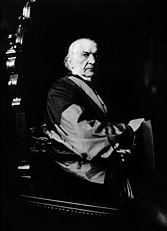Representation of the People Act 1884
 | |
| Long title | An Act to amend the Law relating to the Representation of the People of the United Kingdom. |
|---|---|
| Citation | 48 & 49 Vict. C. 3 |
| Introduced by | William Gladstone |
| Territorial extent | United Kingdom |
| Dates | |
| Royal assent | 6 December 1884 |
| Other legislation | |
| Repealed by | Representation of the People Act 1918 |
| Relates to | Redistribution of Seats Act 1885 |
Status: Repealed | |

In the United Kingdom under the premiership of Gladstone, the Representation of the People Act 1884 (48 & 49 Vict. c. 3, also known informally as the Third Reform Act) and the Redistribution Act of the following year were laws which further extended the suffrage in the UK after the Derby Government's Reform Act 1867. Taken together, these measures extended the same voting qualifications as existed in the towns to the countryside, and essentially established the modern one member constituency as the normal pattern for Parliamentary representation.[citation needed]
The Act extended the 1867 concessions from the boroughs to the countryside. All men paying an annual rental of £10 and all those holding land valued at £10 now had the vote. The British electorate now totalled over 5,500,000. The bill was so objectionable to the House of Lords that Gladstone was forced to separate the legislation into two bills,[1] the second being the Redistribution of Seats Act 1885 which redistributed constituencies, giving more representation to urban areas (especially London).[citation needed]
The 1884 Reform Act did not establish universal suffrage: although the size of the electorate was increased considerably, all women and 40% of adult males were still without the vote.[2][3] Male suffrage varied throughout the kingdom, too: in England and Wales, two in three adult males had the vote; in Scotland, three in five did; but in Ireland, the figure was only one in two.[3]
The following general election took place in 1885.
Key sections of the Act[]
This section does not cite any sources. (November 2020) |
Section 2: This extended a uniform household (freeholder and leaseholder) franchise to all parliamentary boroughs and counties in the United Kingdom.
Section 3: Men inhabiting a dwelling-house as an employee, whose employer did not live there, were to be treated for franchise purposes as if they were occupying as tenants.
Section 4: Prohibition of multiplicity of votes. This was not to stop people acquiring multiple votes in different constituencies (plural voting was still permitted), but to restrict sub-division of one property to qualify multiple voters (so-called faggot voters).
Section 5a: A man who was a £10 occupier in a county or borough was to be a voter in that county or borough. This assimilated the previous county occupation franchise and borough occupation franchise into a uniform occupation franchise.
Section 6: Occupation in a borough was not to confer a county franchise.
Effects[]
As many crofters in the Scottish Highlands qualified as £10 occupiers, the Act empowered Scottish Gaels to take action against evictions and rent increases at the end of the Highland Clearances. Their votes led to the formation of the Crofters' Party and Highland Land League,[4] and eventually the passage of the Crofters' Holdings (Scotland) Act 1886, which addressed many of their grievances and put an end to the Highland Clearances.[5]
See also[]
| Wikisource has original text related to this article: |
- Parliamentary Franchise in the United Kingdom 1885–1918
- Medical Relief Disqualification Removal Act 1885
References[]
- The Statutes: Second Revised Edition, Vol. XVI 1884-1886, (printed by authority 1900)
- ^ McKechnie, The reform of the House of Lords p.49
- ^ Pilkington, Colin (1999). The Politics today companion to the British Constitution. Manchester University Press. p. 134. ISBN 978-0-7190-5303-0.
- ^ Jump up to: a b Cook, Chris (2005). The Routledge Companion to Britain in the Nineteenth Century, 1815-1914. Routledge. p. 68. ISBN 978-0-415-35970-2.
- ^ Crowley, D.W. "The Crofters' Party - 1885 to 1892 The first British independent common people's political party" (PDF). Retrieved 24 April 2017.
- ^ Thomson, Derick S. (1983). The Companion to Gaelic Scotland. Basil Blackwater Publisher Lim., . p. 88. ISBN 0-631-12502-7.
External links[]
Cunningham Glen, W (1885). The Representation of the People Act, 1884, with introduction notes and index. Shaw & Sons.
- 1884 in law
- Representation of the People Acts
- December 1884 events
- United Kingdom Acts of Parliament 1884